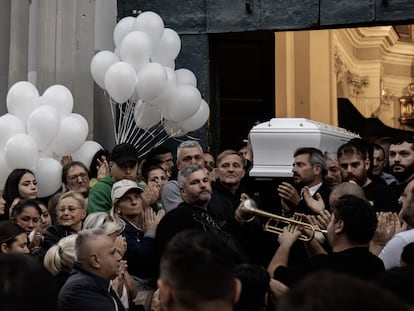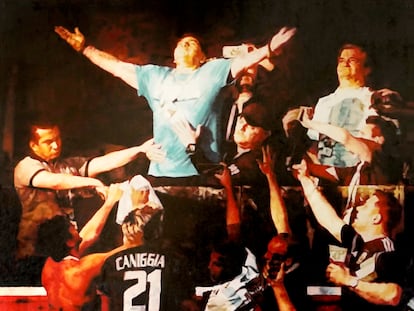Naples, the most difficult secret to tell
The Italian city, excessive and overwhelming, remains a mystery beyond stereotypes. Portraying it well is the great challenge for writers. From Roberto Saviano to Toni Servillo, great names in Neapolitan culture recommend their favorite books about their birthplace
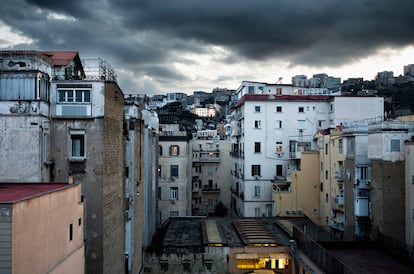
Neapolitans see Naples as a problem, tourists as a kind of enigma. It is a mysterious problem, no doubt about it. The city, which will be 2,500 years old in 2025, has seen mass tourism soar: a 33% increase since 2021, with 14 million visitors this year. After Rome, it is where tourists stay the longest in Italy — an average of three days — a sign that it is perceived to require time. As in other Italian cities, tourism is managing to disfigure even Naples, which seemed unchanged. But the paradox is that the more people go to visit it, the more difficult it is to know; it is increasingly hidden in its stereotypes. Deciphering Naples is one of those recurring challenges of humanity, a literary challenge of the first order, like looking at Vesuvius itself. But its charm is eternal. Elena Ferrante’s four-book saga, the Neapolitan Novels, set in the city and read by millions around the world, was chosen this summer as the best novel of the century by The New York Times. It’s paradoxical, because Ferrante is another enigma; she is a pseudonym, the author a mystery.
Naples also recently welcomed the Spanish monarchs, while the Federico II University awarded an honorary doctorate to Felipe VI, a gesture loaded with symbolism for a city that was Aragonese in the 15th century, then Spanish for two centuries and Bourbon until the 19th century. It has a deep relationship with Spain that, nonetheless, has been largely forgotten. For the Spanish reader, the city is even more enigmatic because some of the essential titles for trying to understand it are not well-known, or even not translated.
In fact, Neapolitans themselves feel overwhelmed by the city. Its contrasts make it unfathomable, from the sunny to the gloomy, from the musical to the brutal, from the baroque to the miserable. And dominating everything, the disturbing presence of a volcano. On many occasions, it has been a stranger, a traveller, a foreigner, who has had the necessary distance to describe it. “Yes, there are things that we do not even see, or understand, because for us they are normal,” explains Antonio Ferrieri, from the historic Colonnese bookshop, open since 1965 in via San Pietro a Majella, in downtown Naples. Nearby, in Piazza del Gesù Nuovo, is another emblematic bookshop, Dante & Descartes: “We feel like we are in the middle of a theme park, the city is losing its soul,” laments Giancarlo di Maio. We asked them and some other Neapolitan personalities for advice on which books they would recommend to really get to know the city.
The city was the most exotic and captivating stage of the Grand Tour, the trip to Italy that every cultured person was required to make in the 18th century
The first reference is usually Goethe, and the pages concerning Naples from his Italian Journey. Eike Schmidt, a German with Italian nationality and director of the Capodimonte Museum, recommends it. “He still says very current things,” he says, and he thinks the same of the texts of the 18th-century Neapolitan philosopher Giambattista Vico. The city was the most exotic and captivating stage of the Grand Tour, the trip to Italy that every cultured person was required to make in the 18th century. The list of personalities who left their impressions in writing is endless, always a fascination between surrendered seduction and visceral horror. The Marquis de Sade himself, in his Journey to Italy, spoke indignantly of the depravity of Naples... and he was the Marquis de Sade. “It is the only city in the East in which there is no residential district for Europeans,” said the journalist and writer Edoardo Scarfoglio ironically. Walter Benjamin was another perceptive visitor who was marked by the city, and who knew how to read it. In Naples, he coined an adjective, that of the “porous” city, which has ended up becoming another stereotype. Schmidt also points to a recent book about Adorno’s stay in Naples by Martin Mittelmeier.
Scarfoglio founded Il Mattino in 1892, which is still Naples’ main newspaper. He did so with his wife, Matilde Serao, one of the first modern authors required to understand the city. In 1884, Serao published The Belly of Naples, devastated by a cholera epidemic. It is an investigation into the city’s misery, the life of the poorest in neighborhoods with inhuman conditions, and the subsequent attempts to cover it up with urban planning operations. It is the initial paradigm of the story about the dark truth of the city, beneath the colors of the postcard, and of the existence of a Naples of those above, the high bourgeoisie, and another of those below, the popolino. Against the same backdrop of the epidemic, a Swedish physician who went to help, Axel Munthe, summarized his experiences in La città dolente (The suffering city), although he is better known for The Story of San Michele, his memories of his life in Capri.
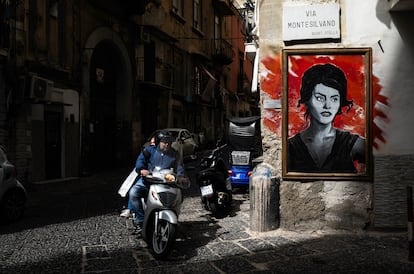
Proof of the difficulty of describing Naples from a fictional perspective is the abundance of reference works that are journalistic, documentary, or autobiographical in nature. The city has been more accessible through poetry and theater than through novels, as if it were an impossible task to enclose it in a story, or to invent something that would not fall short. Furthermore, it is not only a difficult place to understand, but it often turns the writers who try to do so into authors who are misunderstood in the city, rejected.
In the 1920s, the most unclassifiable Spanish writer, perhaps the most suitable for the task, arrived there: Ramón Gómez de la Serna, who settled in 1926 at number 185 Riviera de Chiaia. He immediately fell in love with Naples, saying that he wanted to stay there forever. The following year he published a novel, The Amber Woman, set in the city, but José Vicente Quirante Rives, director of the Cervantes Institute in Naples between 2005 and 2010, prefers a short story, The Man in the Gallery, which De La Serna published in Italian with the publishing house of the Dante & Descartes bookstore. “He noticed a gallery that is not the famous one, the one in the center, but another smaller one opposite the archaeological museum, which never took off, more solitary, and he knew how to capture that melancholy and invented a beautiful story,” explains Quirante Rives. He believes that, among Spanish writers, “he is undoubtedly the one who showed the greatest interest in understanding the city.”
This tension has always persisted between recounting the city’s beauty and its misfortunes. On the one hand, the popular wealth, the wisdom of the streets, the magic of its people. On the other, endemic evils, secular misery, corruption, anarchy and violence
Among Spanish authors, Ignacio Peyró, director of the Cervantes Institute in Rome for the past two years, also highlights the vision of Leandro Fernández de Moratín in Naples, and the writings of the Duke of Rivas, who was ambassador to the city from 1844 to 1851 with another writer, the young Juan Valera, as an attaché and disciple for two years.
The Second World War was a key moment that dramatically marked the history of the city, and once again two outsiders appeared to tell the tale. Both were part of the Allied advance and describe a human landscape devastated by hunger and poverty: the Briton Norman Lewis, in his already classic Naples ‘44, and the Tuscan Curzio Malaparte, a kind of Italian Céline, in The Skin, a brutal story published in 1949 that made him hated throughout the city. It is one of the essential works recommended by Roberto Saviano, for example.
This tension has always persisted between recounting the city’s beauty and its misfortunes. On the one hand, the popular wealth, the wisdom of the streets, the magic of its people. On the other, endemic evils, secular misery, corruption, anarchy and violence. To approach the unique and profound character of the city, there are, for example, Neapolitan Legends, by Serao, or Storie e leggende napoletane (Neapolitan stories and legends), by the philosopher Benedetto Croce.
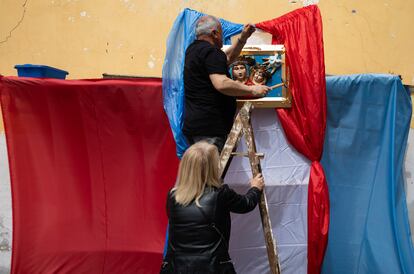
In contrast to The Skin, The Gold of Naples by Giuseppe Marotta appeared around the same time, in 1947. It is a story with a friendly view of the harshness of life after the war, exalting humanity and the ingenuity of the Neapolitan people in their survival. It was adapted for the big screen in 1954 by Vittorio De Sica, who loved Naples and tried to capture the city’s spirit in several films. For example, in The Last Judgement (1961), which recounts how the city reacts to the news that the end of the world is announced for 6 p.m.; the unforgettable first episode of Yesterday, Today and Tomorrow (1963), and Marriage Italian-Style (1964), based on a play by Eduardo De Filippo, the Neapolitan Shakespeare.
The actor Toni Servillo, known for his leading role in The Great Beauty, directly recommends “all the theater of Eduardo De Filippo and Raffaele Viviani.” De Filippo, also an immense actor, displays in his works all the subtlety and depth of comedy and drama that are mixed in life in this city. Another similar icon of Naples — his photo is everywhere — is Totò, again little known outside Italy, because he is untranslatable, moving in a code that is incomprehensible to someone from outside. The same goes for a more modern actor emblematic of the city, Massimo Troisi, who became internationally known with Il Postino: The Postman (1994).
On the other side, which looks out onto the unspeakable, in 1953 the city was shocked by Anna Maria Ortese’s The Sea Does Not Bathe Naples, Chekhovian stories of the slums, chronicles of poverty, and in its second part, a merciless portrait of the local intellectuality. The controversy meant that the writer never returned to Naples, but today it is claimed as another of those books necessary to understand the city.
On many occasions, it has been a stranger, a traveller, a foreigner, who has had the necessary distance to describe Naples
One of the intellectuals who appeared in the book was Raffaele La Capria, who in 1961 won the Strega Prize, the most prestigious in Italy, with The Mortal Wound. It is another unanimously chosen title. It was translated by the small publishing house of Quirante Rives, who is in love with the city and has published some essential titles about Naples in Spain, because he agrees that there is a great lack of knowledge about the city. In his opinion, The Mortal Wound is a masterpiece, “the great book to have a real view of what Naples is, with a prodigious construction.” He also mentions En el cuerpo de Nápoles, by Giuseppe Montesano.
The former mayor of Naples in the 1990s, Antonio Bassolino, also points to L’armonia perduta (The lost harmony) by La Capria, which “explains the fracture between the people and the bourgeoisie.” La Capria is also one of the declared sources of inspiration for the director Paolo Sorrentino, who tried to make a film of The Mortal Wound, but abandoned the project. In May, his film about his city, Parthenope, premiered at Cannes. Sorrentino is one of those Neapolitans who have left Naples, another Neapolitan character in himself, with a difficult relationship with the city, which he loves but where he cannot live. After masterfully portraying Rome in The Great Beauty (2013), he had a similar film about Naples pending, a definitive portrait of the city. Parthenope, a box office success, has divided Naples.
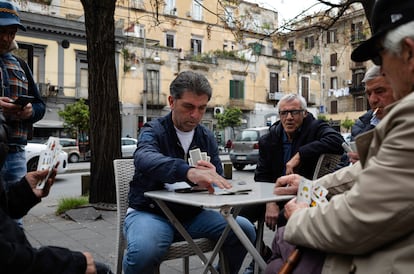
Another novel that comes up again and again is a historical recreation of the city at the end of the 18th century, Il resto di niente (The rest of nothing) by Enzo Striano (1986.) Roberto Saviano speaks about it enthusiastically: “It is the great story of the only Italian revolution, in 1799, a phenomenal book to understand plebeian Naples, the revolutionary dream… Neapolitan intellectuals inspired the French Revolution, and in return, Naples saw the only Jacobin revolution. It is the story of a rebellious and untamed city, always divided between revolution and counter-reformation.”
Among the books of recent decades, another foreigner stands out — Thomas Belmonte — again with an almost documentary book, The Broken Fountain, published in 1979 and a candidate for the Pulitzer that wasn’t translated in Italy until 1997. Belmonte was an American anthropologist who arrived in Naples in 1974 and spent a year living in one of the city’s neighborhoods, immersing himself in the daily life of his neighbors, in the obsession with survival, between violence and illegality. There is also a strange book, now a cult one, because it disappeared from circulation at the request of its author. It was not republished until his death, in 2012: Malacqua (1977), the only novel written by the journalist Nicola Pugliese. It was a discovery by Italo Calvino, who was impressed by the text, which was written in a month and a half.
The city has been more accessible through poetry and theatre than in the novel, as if it were impossible to enclose it in a story.
In recent decades, Domenico Starnone and Erri De Luca, two other Neapolitans who have left the area, have stood out. The work of Starnone, who is periodically pointed out as the writer behind Elena Ferrante, together with his wife, Anita Raja — something he denies — has been published by Lumen and now Altamarea is publishing one of his most acclaimed novels, Via Gemito, from 2001. Starnone, another of those consulted, recommends three books: Mistero napoletano (1995), by Ermanno Rea, and L’ abusivo (2001), by Antonio Franchini, together with another by the same author published this year, Il fuoco che ti porti dentro (The fire you carry within you). De Luca, for his part, has explored his childhood in the city in Not Here, Not Now (1989); Montedidio (2002), and Napòlide (2014). He left Naples aged 18, but says in this latest book that as the train pulled away “the city was getting under my skin like a fishing hook.”
More recently, the shock of Saviano’s Gomorrah (2006) still resonates, another denunciation against the underworld, and another author criticized and persecuted for it. Among the most recent authors are Gianni Solla, whose The Notebook Thief has just been published by Tusquets, and two very popular writers in Italy, as their creations have also been turned into television series: Maurizio De Giovanni and his Commissario Ricciardi; and Diego De Silva and his lawyer Vincenzo Malinconico. Two other characters moving in the chaos, trying to understand it.
Sign up for our weekly newsletter to get more English-language news coverage from EL PAÍS USA Edition
Tu suscripción se está usando en otro dispositivo
¿Quieres añadir otro usuario a tu suscripción?
Si continúas leyendo en este dispositivo, no se podrá leer en el otro.
FlechaTu suscripción se está usando en otro dispositivo y solo puedes acceder a EL PAÍS desde un dispositivo a la vez.
Si quieres compartir tu cuenta, cambia tu suscripción a la modalidad Premium, así podrás añadir otro usuario. Cada uno accederá con su propia cuenta de email, lo que os permitirá personalizar vuestra experiencia en EL PAÍS.
¿Tienes una suscripción de empresa? Accede aquí para contratar más cuentas.
En el caso de no saber quién está usando tu cuenta, te recomendamos cambiar tu contraseña aquí.
Si decides continuar compartiendo tu cuenta, este mensaje se mostrará en tu dispositivo y en el de la otra persona que está usando tu cuenta de forma indefinida, afectando a tu experiencia de lectura. Puedes consultar aquí los términos y condiciones de la suscripción digital.
More information
Archived In
Últimas noticias
The complicated life of Francesca Albanese: A rising figure in Italy but barred from every bank by Trump’s sanctions
How Japan is trying to avert ‘digital defeat’
Half of Scotland is in the hands of 420 property owners
Reinhard Genzel, Nobel laureate in physics: ‘One-minute videos will never give you the truth’
Most viewed
- Pablo Escobar’s hippos: A serious environmental problem, 40 years on
- Reinhard Genzel, Nobel laureate in physics: ‘One-minute videos will never give you the truth’
- Why we lost the habit of sleeping in two segments and how that changed our sense of time
- Charles Dubouloz, mountaineering star, retires at 36 with a farewell tour inspired by Walter Bonatti
- The Florida Keys tourist paradise is besieged by immigration agents: ‘We’ve never seen anything like this’

